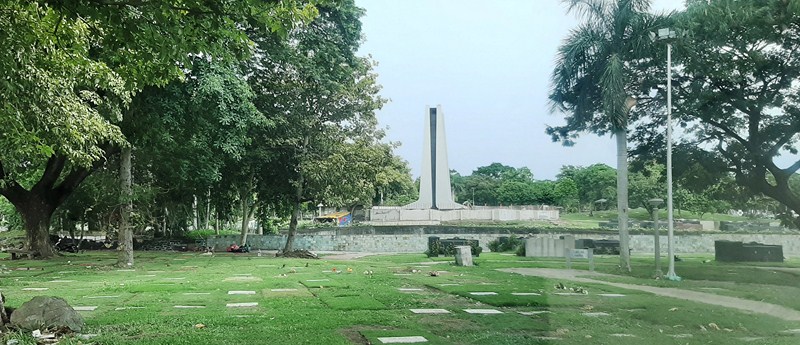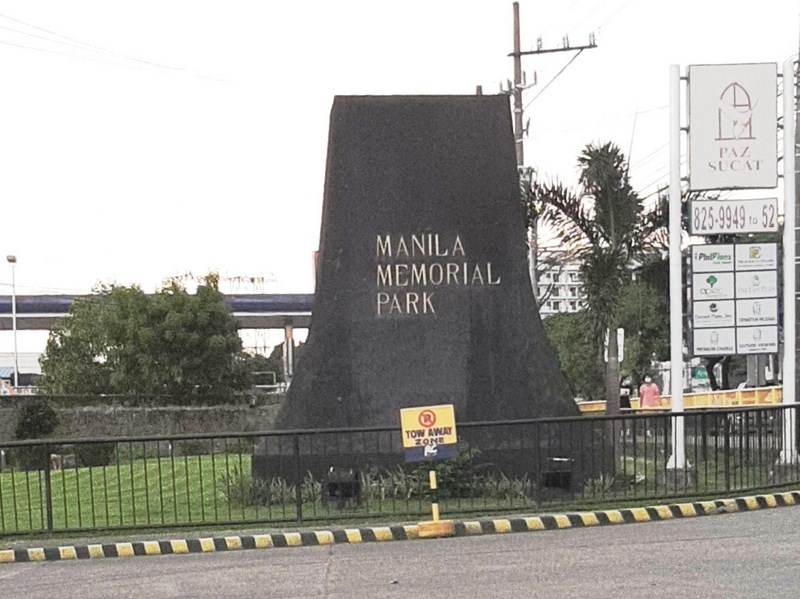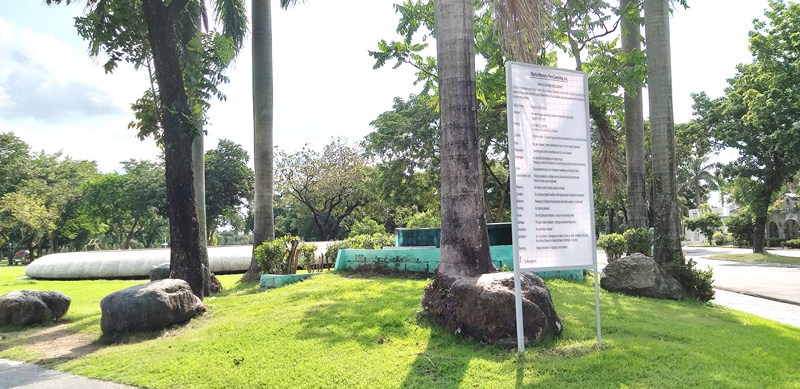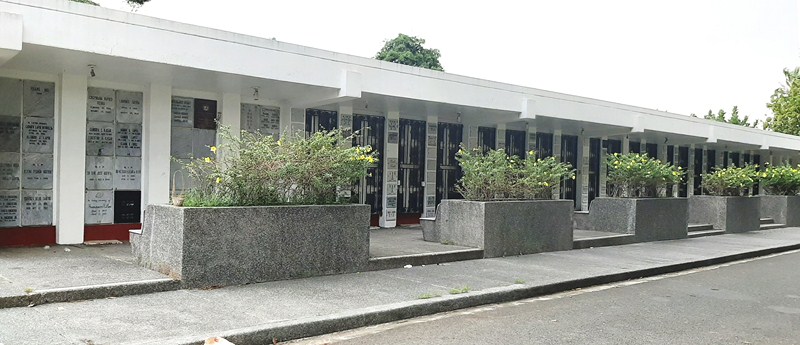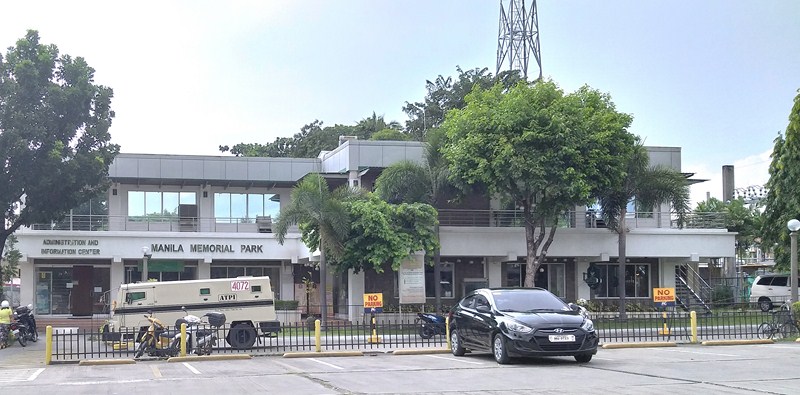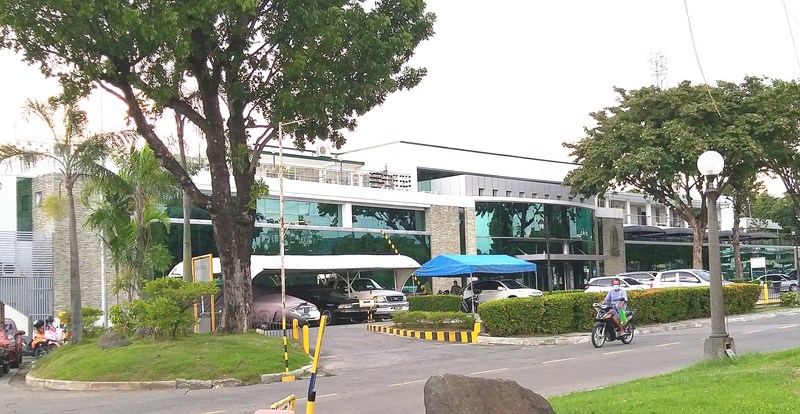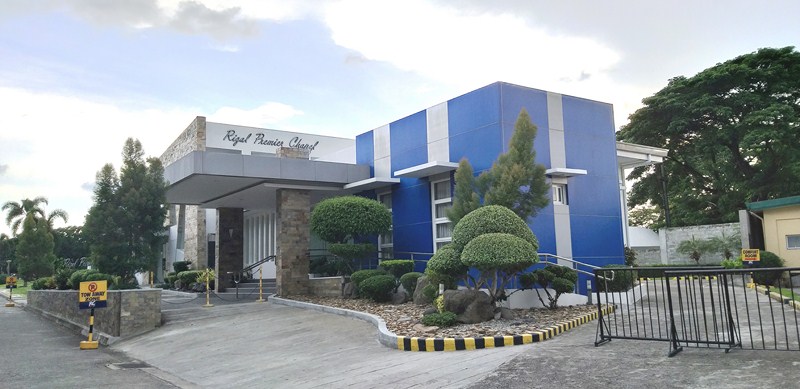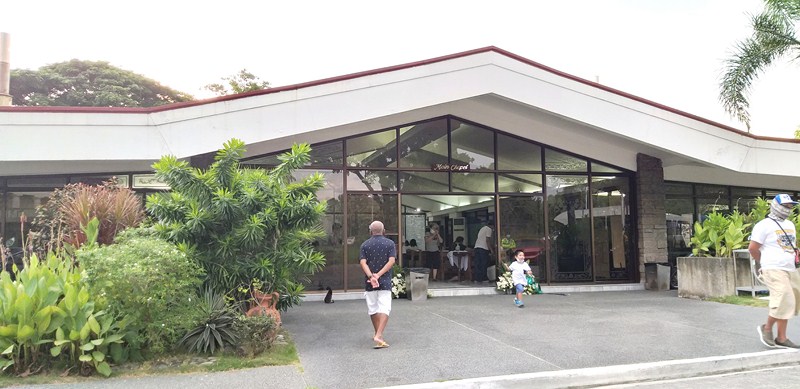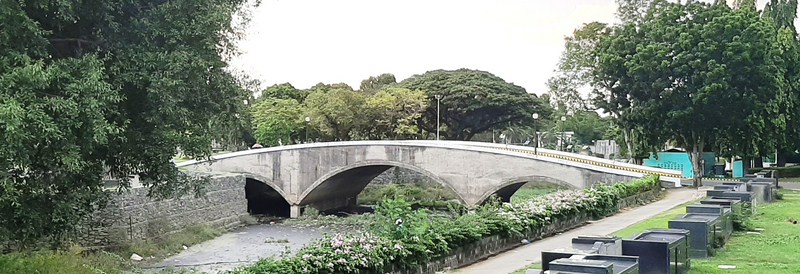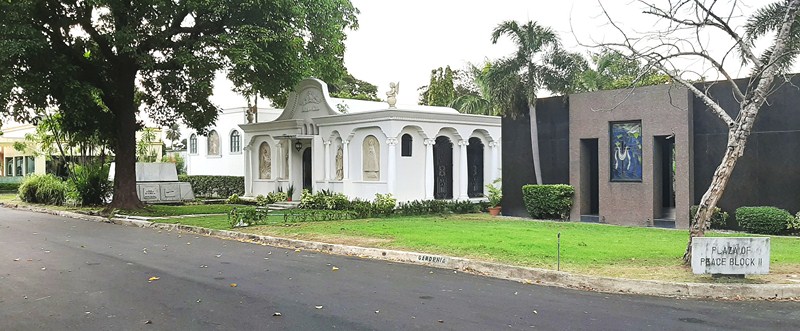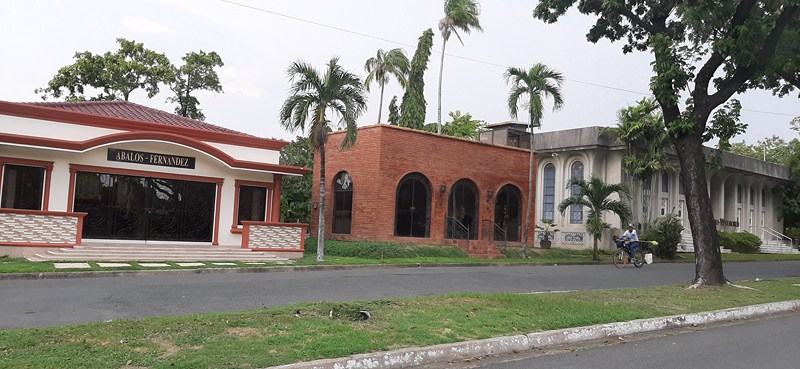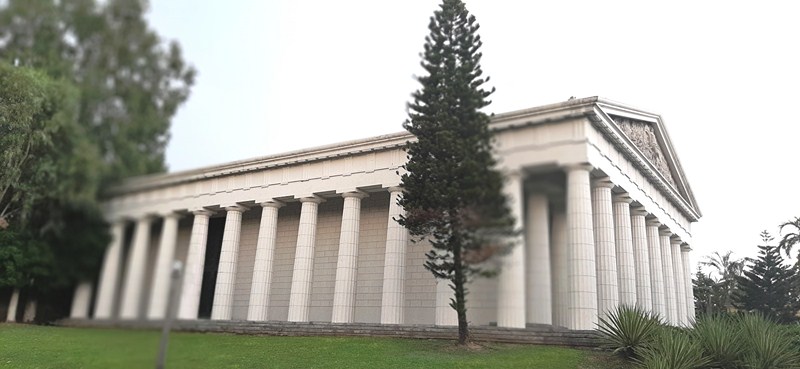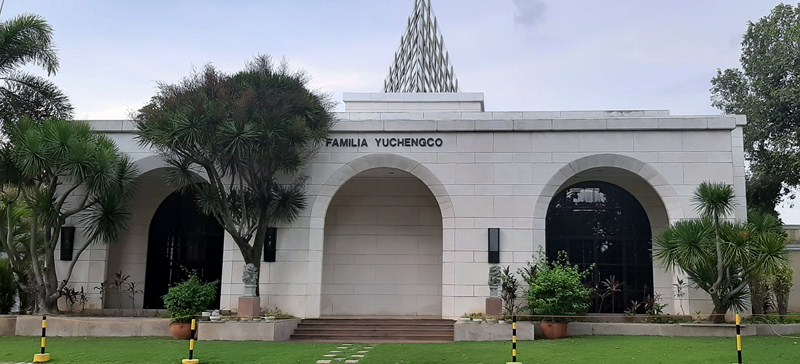Due to the COVID 19 imposed social distancing requirement, all memorial parks and cemeteries were slated to be closed from October 29 to November 3. All Saints’ Day was still a month away but I now decided to make an early visit to the 142-hectare Manila Memorial Park (MMP) where my parents, father-in-law, paternal grandparents and two of my first cousins are buried.
This would be my second travel outside our subdivision since the lockdown started six month ago and the first time with me driving. Bringing along my son Jandy, I also experienced my first traffic gridlock since the lockdown, with heavy traffic around the City Hall area.
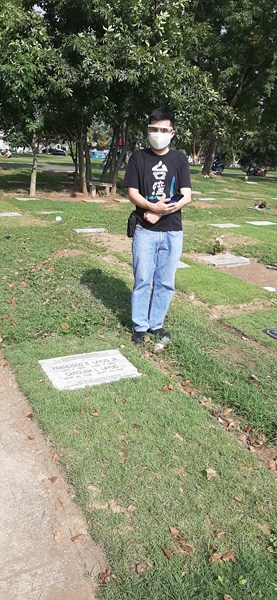
Jandy beside the plot of his grandparents who are buried in a lawn lot (only underground burials allowed), double tierred (you may inter two fresh bodies underground) contained in sealed concrete vaults. Interments are marked with flat markers (lapidas) of uniform size and make
The Manila Memorial Park (MMP) was established in 1964 when Parañaque, now a city and a part of Metro Manila, was still a municipality of Rizal province. The first company to introduce the memorial park concept in the Philippines, in the past, the Filipino idea of burial was to place dead bodies inside protruding stone tombs. Manila Memorial Park changed all that with the introduction of the Western concept of lawn burials where the dead are buried in a lawn setting of open, manicured and green fields, with trees and garden in the perimeter, and with the grave markers on top.
Now the largest memorial park developer in the country (with a total of 427 hectares, 242 of which are fully developed), the flagship cemetery became part of a larger network of burial sites of Manila Memorial Park, Inc. with five other beautifully-maintained memorial parks, under the Manila Memorial Park brand, opened in other parts of the Philippines with three (aside from MMP) in Luzon (MMP – Holy Cross in Novaliches in Quezon City; the 128-hectare MMP – Dasmariñas in Cavite, opened November 1991; the 45-hectare MMP-Bulacan in Plaridel, opened June 1998) one in the Cebu (the 40-hectare MMP – Cebu) in the Visayas and one in Davao City (MMP – Davao) in Mindanao.
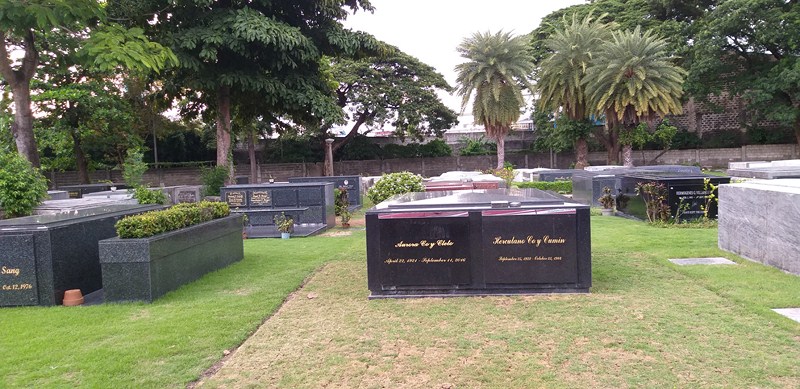
Double niche measuring 4 m. x 4.88 m. (19.52 sq. m.) with 8 single tiered underground burials and 2 above ground niches (optional), a total of 10 burials spaces.
After Pope John Paul II lifted the ban on cremation for Catholics in 1983, MMP built a crematorium in August 1985, becoming the first cemetery to host a modern crematorium in a memorial park setting.
Currently, Manila Memorial Park operates four sets of crematories, one in its Sucat Park, the second in Holy Cross in Novaliches, Quezon City., the third in Dasmariñas in Cavite, and the fourth in its Bulacan park.
For the sake of convenience (not to mention sparing the city’s already traffic-prone streets from even worse traffic), wakes can be held at 3 venues all set amidst the Park’s signature lush greenery – the park’s old main chapel and two spacious, clean and modern air-conditioned branches of popular funeral homes in the metropolis.
In 2001, MMP partnered with La Funeraria Paz & the House of Investments to open Paz Memorial Chapels – Sucat, a full-service mortuary set in a modern 3-story edifice right inside MMP’s flagship park. The Rizal Premier Chapel, a new funeral venue, was built from December 2016 to August 2017.
Aside from utility, memorial parks, as sacred and serene places for rest, comfort and inspiration, also operate on the concept of beauty, both natural and man-made. Within the park are at least 250 species of trees, flowering shrubs, ornamental plants, cacti, succulents, ferns, orchids and even variegated palms, most of them planted by the park management or by the families. Ayahuma or cannonball tree (Couroupita guianensis), frangipani (Plumeria rubra, locally called kalachuchi) tree, dita trees (Alstonia scholaris), fish poison tree (Barringtonia asiatica, locally called botong, bitun, bitung or boton), several ficus trees, bougainvillea hybrids and hedge plants are extensively used in the park landscaping.
At least 2 dozen bird species (Eurasian tree sparrow, Philippine pied fantail, turtle doves, pigeon, etc.) also call the park as home while the the wooded areas also host a number of bats, butterflies and bees. An informal jogging group also meet at the park.
A creek, crossed by bridges, flows within the park. The Meditation Tower, one of the landmarks in the park, is modeled after two hands clasped in prayer. Inside is a large metal-welded sculpture of the Risen Christ flanked by burial niches.
Of course, no memorial park, or cemetery for that matter, is complete without mausoleums of all shapes and sizes. Mausoleums stand as proof of a surviving family’s love for their deceased loved ones and some of the grandest and most beautiful mausoleums in the country can be found in the park. Just like luxury residences (in this case, for the dead), some of them are exquisitely designed.
Many consider the MMP as the southern and more contemporary equivalent of the Manila Chinese Cemetery, with many Filipino-Chinese buried here, a lot of them entombed within exquisite and sometimes massive mausoleums. Some have traditional mini censers (where incense is lit to honor their dead) usually seen beside a Chinese tomb.
Symbolizing the highest form of immortalizing your loved ones, mausoleums (or family estates) are available in clusters of 18, 24, 36 and 96 lots. Each lot in the family estate allows for one underground burial, contained in a sealed concrete vault. The construction of a mausoleum, whether open or closed-type, is subject to inventory and Company regulations. The incorporation of bone boxes or columbary niches in the mausoleum is allowed and comfort rooms are allowed to be built inside the mausoleum..They are classified into the following:
- Junior Estate (24 lots) – an open type of mausoleum that may contain not more than six above ground tombs, while a closed structure may contain up to 12 above ground tombs. A comfort room is allowed inside the mausoleum.
- Garden Estate (15 lots) – may construct a memorial structure or mausoleum which shall not exceed 35% of the property size and not more than 3 m. in height.
- Prestige Estate – measuring 6 m. x 7.32 m. (43.92 sq. m.) with 18 single tiered lots. Construction of the mausoleum’s height must not exceed 3 m.. A maximum of 4 niches and a comfort room is allowed inside the mausoleum.
- Senior Estate – Measuring 9 m. x 9.76 m. (87.84 sq. m.) with 36 single tiered lots. Constructions of mausoleum is allowed but not to exceed 50% of the property. Mausoleum’s height must not exceed 5 m.. A comfort room is allowed inside the mausoleum.
- Premier Estate.(96 lots) – construction of this mausoleum shall not exceed 5 m. in height. An open structure may contain a maximum of 20 above-ground tombs while a closed one may contain a maximum of 40 above ground tombs. A comfort room is allowed inside the mausoleum.
The largest mausoleum in the park is a huge, multi-column mausoleum, reminiscent of the Greek Parthenon (an ancient temple dedicated to goddess Athena), sitting on a 1,383-sq. m. land or about 500 lots and said to be owned by Po family. In front is a short, Egyptian-inspired obelisk.
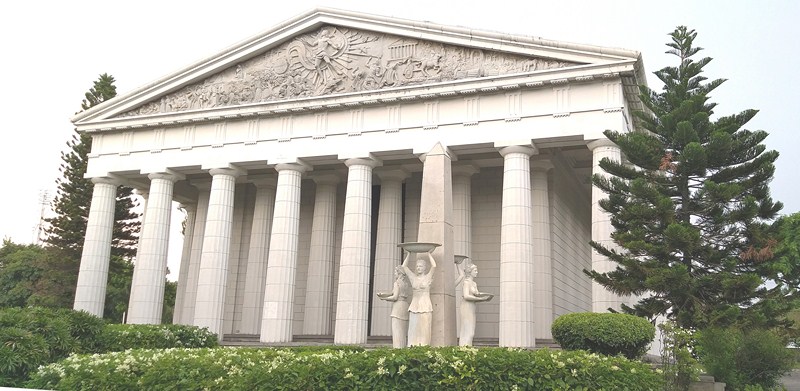
In front of the mausoleum is an Egyptian-style obelisk surrounded by statues of female figures. The pediment depicts scenes in the life of Christ, notably his Resurrection
The Memorial Memorial Park is the burial site of notable Filipino individuals which includes a president, four senators, a Cabinet secretary, 2 city mayors, a number of actors, a noted fashion designer and a world champion boxer.
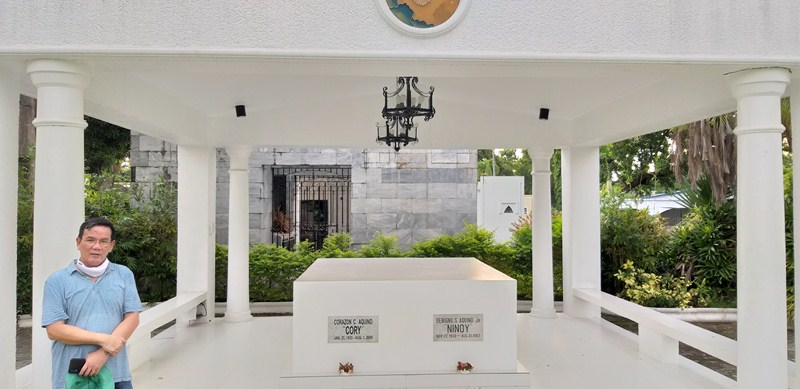
The author at the Aquino Mausoleum. My guess is this is a basic unit consisting of 12 contiguous lots with option to construct 2 above ground tombs with back wall and overhang type of roofing. All sides of the structure are open. Cory Aquino tomb is on the left and Ninoy Aquino is on the right
- Corazon C. Aquino (January 25, 1933–August 1, 2009) – 11th President of the Philippines and the first woman to hold that office (Plaza of Dignity XIX).
- Benigno S. Aquino Jr.(November 27, 1932–August 21, 1983) – Senator of the Philippines, governor of the province of Tarlac and husband of Corazon Aquino (Plaza of Dignity XIX).
- Narciso R. Ramos (November 11, 1900–February 3, 1986) – former Minister of Foreign Affairs and father of former president Fidel V. Ramos and Philippine Senator Leticia Ramos-Shahani.
- Leticia Ramos-Shahani (September 30, 1929 – March 20, 2017) – Senator of the Philippines and the younger sister of former president Fidel V. Ramos
- Josephine “Jo” M. Ramos (January 18, 1957–June 27, 2011) – musician, athlete and daughter of former president Fidel V. Ramos
- Sotero H. Laurel (September 27, 1918 – September 16, 2009) – Senator of the Philippines and the older brother of former Vice President Salvador Laurel
- Robert Z. Barbers (January 19, 1944 – December 25, 2005) – police officer, Secretary of the Interior and Local Government and Senator of the Philippines
- Leandro R. Mendoza (March 17, 1946 – October 7, 2013) – former Secretary of Transportation and Chief of the Philippine National Police
- Dulce Q. Saguisag (September 5, 1943 – November 8, 2007) – former Secretary of Social Welfare and Development and husband of former senator Rene Saguisag
- Nereo C. Andolong (1926–October 31, 2001) – former chairman and general manager of the Philippine Charity Sweepstakes Office and president of Philippine Olympic Committee
- Pablo Cuneta (February 2, 1910 – September 27, 2000) – former Mayor of Pasay
- Maria Clara Lobregat (April 26, 1921 – January 2, 2004) – former Mayor of Zamboanga City
- Antonello-Joseph “AJ” Perez (February 17, 1993 – April 17, 2011) – actor and member of ABS-CBN’s Star Magic in Batch 13
- Jose “Pitoy” Moreno (February 25, 1925 – January 15, 2018) – Filipino fashion designer and one of the earliest advocates of the Maria Clara gown.
- Jam Sebastian (March 20, 1986 –March 4, 2015) – actor and internet personality
- Francisco “Paquito” B. Diaz ((May 28, 1932 – March 3, 2011) – veteran Filipino actor and movie director
- Ricardo “Rico” C. Yan (March 14, 1975 – March 29, 2002) – Filipino matinee idol, model, film and television actor
- Alfonso “Alfie” S. Anido (December 30, 1959 – December 30, 1981) – popular Filipino matinee idol
- Gabriel “Flash” Elorde (March 25, 1935 – January 2, 1985) – Filipino professional boxer who won the inaugural WBC and WBA super featherweight titles.
- Arsenio “Dodjie” H. Laurel (December 14, 1931 – November 19, 1967) – race car driver and the first two-time winner of the Macau Grand Prix, winning it consecutively in 1962 and 1963.
- Helen Vela (October 31, 1946 – February 14, 1992) – Filipino actress, radio/TV host and news anchor
- Orly J. Punzalan (September 9, 1935 – January 6, 2005) – radio/TV host and news anchor
- Mariano Contreras (July 12, 1910 – December 12, 1978) – better known by his stage name Pugo, was a Filipino actor, comedian, vaudevillian, and film director
- Enrique “Ike Lozada (August 13, 1940 – March 8, 1995) – Filipino comedian, actor and TV host.
- Inday Badiday (August 6, 1944 – September 26, 2003) – radio/TV host and journalist
- Bayani Casimiro, Sr.(July 16, 1918 – January 27, 1989) – Filipino dancer who was among the leading stars of bodabil (vaudeville) in the 1930s and 1940s.
- Jose “Dindo Fernando” Chua Surban (November 19, 1940–August 27, 1987) – actor
- Miguel B. Rodriguez (November 23, 1961 – February 14, 1997) – Filipino actor and model.
- Victor “Vic” Silayan (January 31, 1929 – August 30, 1987) – Filipino actor who is best known for his roles in Kisapmata
- Maria Rosario “Chat” Silayan (July 8, 1959 – April 23, 2006) – Filipino beauty queen , actress and daughter of actor Vic Silayan.
- Renato “Rene” L. Requiestas (January 22, 1957 – July 24, 1993) – Filipino actor and comedian
- Maria Theresa “Tita” S. Muñoz (1927– April 11, 2009) – actress
- Diomedes Maturan (August 16, 1940 – April 7, 2002) – tagged the “Perry Como of the Philippines” and “The Golden Voice,” was an actor who played in Botika sa Baryo (1960) and a grand champion in Tawag ng Tanghalan.
- Fred Panopio (February 2, 1939 – April 22, 2010) – Filipino singer and actor who rose to fame in the 1970s and is known for having made the yodeling style of music famous in the Philippines.
- Teodoro F. Valencia (May 7, 1913– May 4, 1987 ) – Filipino journalist and columnist
- Kerima Polotan Tuvera (December 16, 1925 – August 19, 2011) – Filipino fiction writer, essayist, and journalist
- Eugenio “Geny” M. Lopez Jr.(November 4, 1928 – 28 June 28, 1999) – chairman of ABS-CBN Broadcasting Corporation
- Margarita “Maita” F. Gomez(May 23, 1947 – July 12, 2012) was a Filipino scholar, beauty queen and women’s rights advocate.
- Lauro Vizconde (1938–February 13, 2016) – former Vice-Chairman and founding member of Volunteers Against Crime and Corruption (VACC)
- Horacio “Atio” Castillo III (May 26, 1995–September 17, 2017) – UST law student and victim of hazing
- Alfonso Yuchengco (February 6, 1923 – April 15, 2017) – businessman, owner of Rizal Banking Corporation
Manila Memorial Park – Sucat: Dr. A. Santos Avenue, Sucat, Parañaque, Metro Manila, Philippines. Tel: (02) 820-2392 and (02) 820-1577. Fax: (02) 826-3917.
How to Get There: From South Luzon Expressway (SLEX), take Sucat exit. Go towards the direction of Baclaran/Airport. Manila Memorial Park-Sucat is on the left side.

